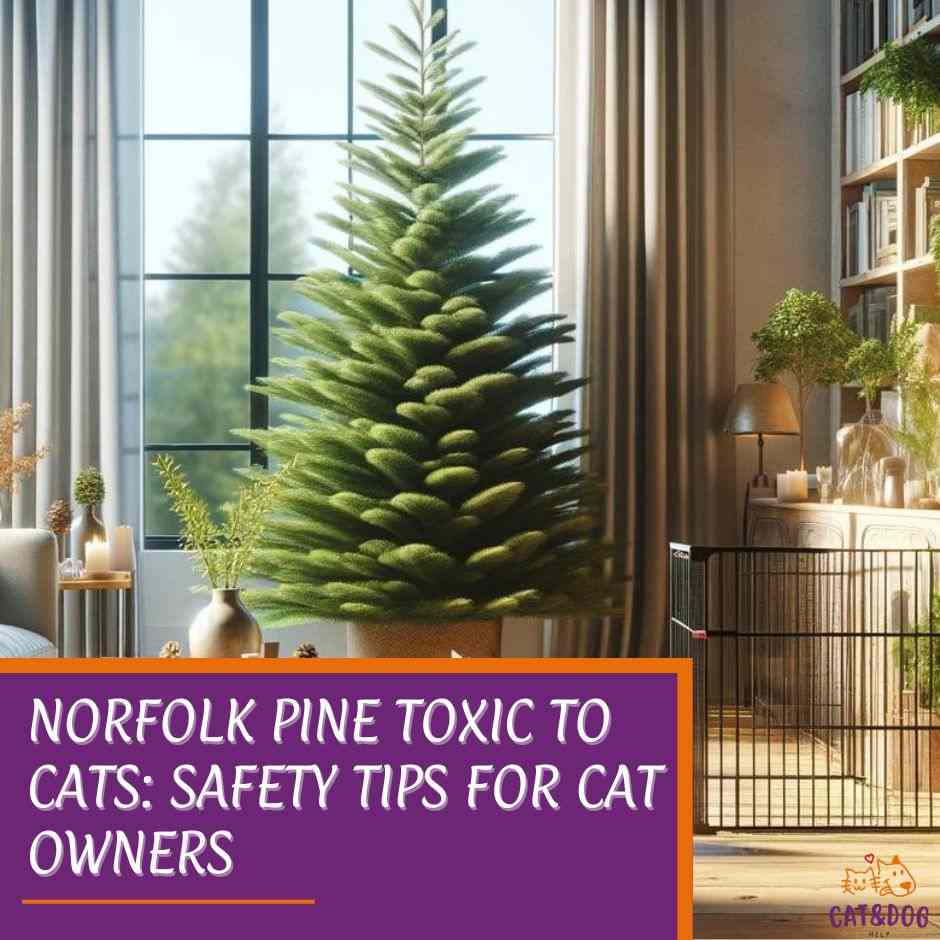The Norfolk Pine, with its symmetrical shape and soft, evergreen needles, has become a coveted houseplant for its elegant appearance and resemblance to a miniature Christmas tree. But, is Norfolk Pine toxic to cats?
Norfolk Island Pine is considered non-toxic to cats, however, due to its toxic components found in its needles or water source, it can cause digestive issues if it is consumed in large amounts. (1)
While Norfolk Pine poses minimal risk, focusing on toxic houseplants ensures your home remains a safe and vibrant environment for your curious feline companions.
The tree is not just the festive charm that wins over plant enthusiasts; its adaptability to indoor conditions makes it a popular choice for the houseplant industry and green-thumbed decorators.
Large numbers of Norfolk Island Pines are produced annually in South Florida for the houseplant industry, with the majority being shipped to grocery stores, discount retailers, and garden centers during November, just in time to be sold as Christmas trees.
Its distinctive appearance, with its widely spaced branches and symmetrical, triangular outline, makes it a desirable choice for decorative landscaping, use as a houseplant, and display as a Christmas tree.
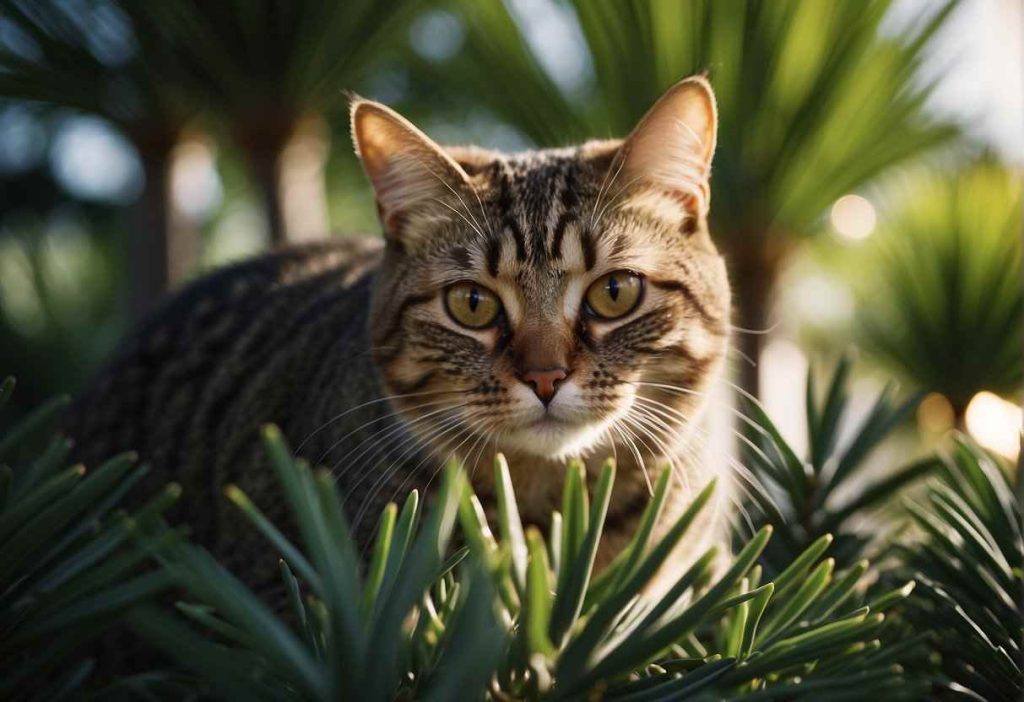
Ensuring the safety of your pets is paramount when bringing new plants into your living space. With their inquisitive nature and propensity to nibble on foliage, cats can be particularly at risk.
Cat owners must be aware of which plants may pose a hidden danger. With conflicting information floating around, it can be difficult to determine whether Norfolk Pine is harmful to your cat.
This article is here to ease your mind and furnish you with reliable information, including the potential hazards of fertilizers and other chemicals used on plants, offering you peace of mind as you cultivate a pet-safe plant environment.
Key Takeaways
- Norfolk Pines are appealing indoor plants with potential risks for cats.
- Identifying and responding to toxicity symptoms in cats is crucial.
- Consultation with vets and authoritative resources ensures pet safety.
Is Norfolk Pine Toxic to Cats?
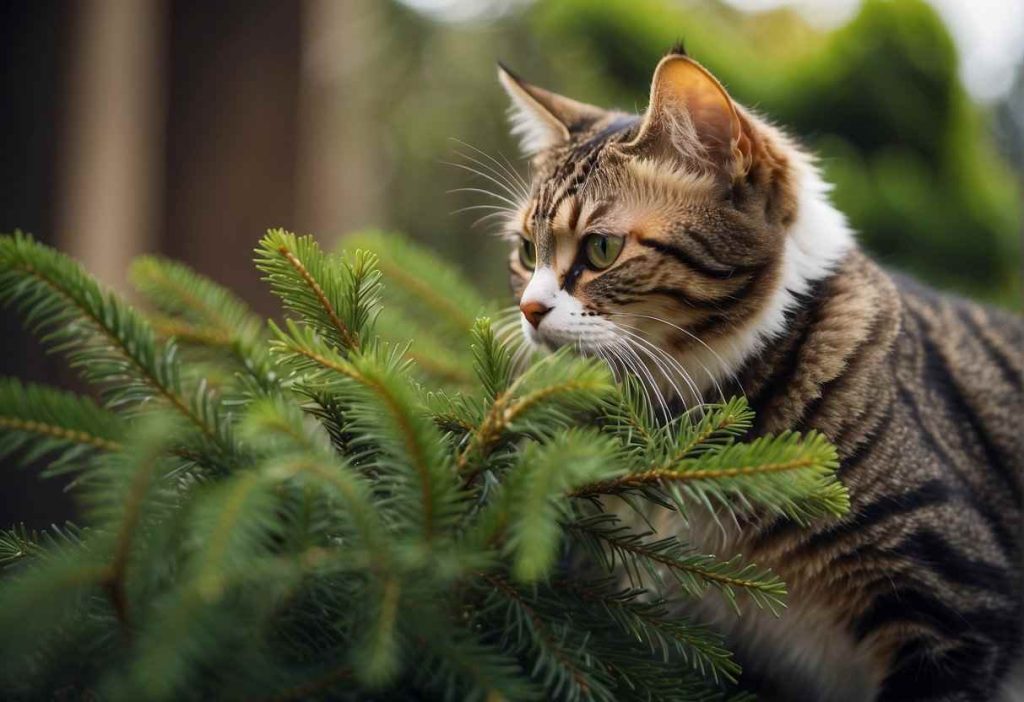
You might be wondering if your feline friends can safely share the space with this festive plant. Well, let’s dig into the facts.
Some sources, including certain veterinary books, suggest that all parts of Norfolk pines can be potentially harmful to cats.
Surprising, right? But it gets a bit confusing, as other information, such as that from discussions around ornamental plants, considers Australian Pine, also known as Norfolk Pine, House Pine, or Norfolk Island Pine, as non-toxic to cats. (2)
However, it is important to note that while Norfolk Pine may not be toxic, it is still not a part of a cat’s natural diet and can cause digestive issues if consumed in large amounts.
As pet owners and caregivers, it is important to be aware of potential hazards and take necessary precautions to ensure the safety of our feline friends, including keeping them away from any potential plant matter that may cause harm.
Here’s the scoop: it appears there’s no consensus on the issue.
The American Society for the Prevention of Cruelty to Animals (ASPCA), which is a go-to authority on pet safety, does not list Norfolk Island Pine as toxic.
However, it is important to note that some sources suggest that the ingestion of pine needles, including those of the Norfolk Island Pine, can cause gastrointestinal signs and lethargy in pets due to toxic components found in the tree’s needles or water source.
Typically, if a plant is harmful, it’s due to specific toxic compounds it contains—which, in the case of the Norfolk Pine, haven’t been conclusively identified.
Yet, caution can never be overrated, right?
You Might Also Want to Know… – Is Norfolk Island Pine toxic to cats? Yes, Norfolk Island Pine is toxic to cats due to its toxic components found in its needles or water source.
What are the symptoms of Norfolk Island Pine poisoning in cats? Symptoms of Norfolk Island Pine poisoning in cats include vomiting, diarrhea, lethargy, and loss of appetite. If your cat’s vomit is not normal, you should be suspicious..
In addition, pet owners should be aware of the potential risks and take necessary precautions to avoid Norfolk Island Pine poisoning in their cats.
While ensuring the safety of plants like Norfolk Pine in your home, don’t forget to also safeguard your cats from other indoor adventures, such as chasing and ingesting moths. It’s all part of creating a secure environment for our curious feline companions.
If you’ve got a curious kitty who just loves to nibble on anything green, it’s probably best to play it safe. Keep an eye on them to avoid any potential health issues. Here’s what you might look out for:
Unfortunately, there aren’t many documented case studies or statistics specifically involving Norfolk Pine and cats.
So, your best bet is to consult your vet if you notice anything off with your cat or experience any concerns about their health after a nibbling session.
Remember, every cat is different, just like us! Some might experience mild reactions, while others might not be affected at all. When in doubt, a call to your friendly local veterinarian can put your mind at ease.
After all, what’s better than a safe home for both you and your fluffy companions?
It’s important to understand the prognosis and follow-up care for your cat if they do happen to ingest Norfolk Pine, as prompt treatment such as inducing vomit can greatly improve their chances of a full recovery.
However, it’s crucial to watch out for any signs of oral irritation, such as redness and swelling around the lips and nose, as well as breathing difficulties due to throat inflammation.
If you notice any of these symptoms, seek immediate veterinary care for your cat to prevent further ingestion of the toxic plant.
Keep those tails wagging and paws prancing safely around the houseplants!
Recognizing the Symptoms of Poisoning
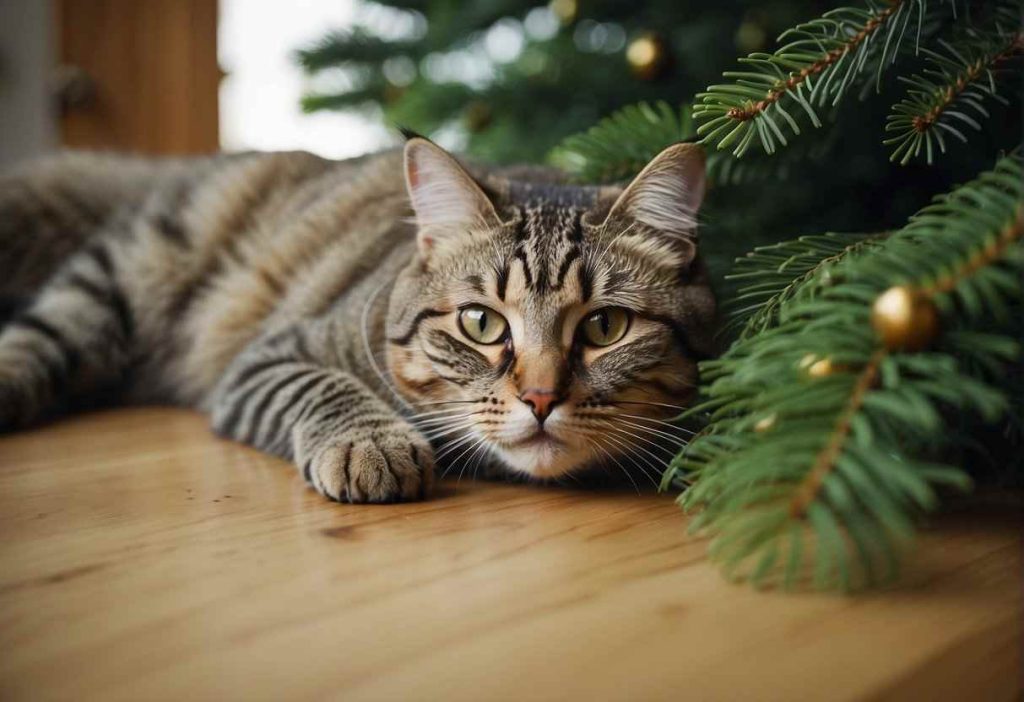
It’s time to play detective because they might not be feeling too paw-some. Let’s spot the clues!
Immediate Symptoms: Keep a close watch; early signs of distress often include: (5)
- Excessive drooling: A little droplet here or there isn’t a telltale sign, but if it’s looking like a miniature waterfall, that’s a red flag.
- Vomiting: One too many hairballs? Maybe. But if your kitty can’t seem to keep their meals down, something’s up.
- Diarrhea: We all know the drill, but this isn’t just an upset stomach – it can be a distress signal.
- Lethargy: If they’re not their usual curious self and prefer a somber snooze instead, you’ve got yourself another hint.
Sometimes, though, symptoms sneak up on you hours later. Here’s what might spring up: (6)
- Trouble breathing: Not the usual furball cough – this could be more of a struggle for air.
- Trembling: It’s not the cute shivers, it’s more “I feel yucky” shakes.
Don’t just fur-reeze if you see these signs! Rushing to your vet could make all the difference. And remember, it’s better to be the cautious cat owner who made a vet visit for nothing than the one wishing they had.
Keep this list handy because acting quickly can save your feline friend from a lot of trouble. Keep it purr-sonal, and don’t take any risks with your cat’s health. Stay informed, and stay prepared!
Immediate Response to Suspected Poisoning
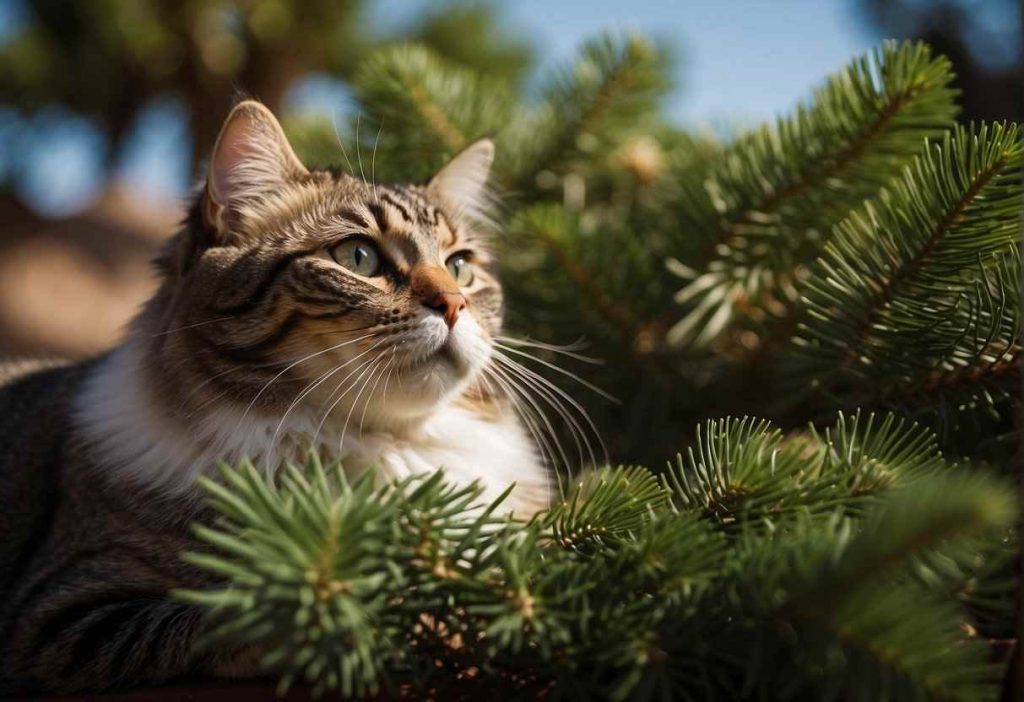
Here’s what you’ve got to do.
- Identify the symptoms: Is your cat vomiting, drooling, or showing signs of mouth irritation? These could be red flags!
- Remove the plant: Safely remove any tree pieces from your cat’s mouth or reach. No more munchies for Mr. Whiskers.
- Clean up: Gently rinse your cat’s mouth with water. It helps clear out any remnants of the plant.
Staying calm is your superpower now. Got that? Awesome! On to the next steps:
- Don’t try home remedies or induce vomiting unless directed by a vet. Your intuition is great, but let’s trust the professionals to take the lead.
- Save a sample of the plant. It could be crucial for your vet to see what’s been ingested.
Now, grab that phone and:
- Call your vet or an emergency pet poison hotline. Quick! The number to dial for an emergency animal poison hotline is 1-888-426-4435.
Have these numbers on speed dial. You never know when they could come in handy. Keep your cool, and get your cat to the pros. They’ll take it from there—for peace of mind and your kitty’s well-being.
Remember, you’re not alone in this. Your furry buddy has you, and together, you’ve got this!
Preventing Norfolk Pine Toxicity

First thing’s first, positioning. Keep your Norfolk Pine in a spot that’s like Mount Everest for your kitty—hard to climb and even harder to conquer. Think:
- High shelves
- Rooms with restricted access
- Behind barriers if necessary
Remember, cats are natural-born acrobats, so a good climbing challenge might not deter them. Double-check for any “launching pads” that could give them a boost!
Now, let’s talk deterrents. Cats hate certain smells, right? Spritzing a bit of citrus-scented water around your plant can send Fluffy running in the opposite direction. Or try these non-toxic options:
- Aluminum foil around the pot (cats dislike the feel)
- Double-sided tape (another texture they’re not fond of)
Sometimes, it’s all about distraction. With these tantalizing non-toxic plant alternatives, your cat can have their own green haven:
| Safe Plant Buddies | Attractions for Cats |
| Boston Fern | Wispy and fun to nudge |
| Spider Plant | Catnip-like effects |
| Bamboo Palm | Sturdy and resilient |
Sprinkle catnip around these, and your Norfolk Pine becomes old news.
Lastly, if your kitty is a bit of a muncher, monitor any strange behavior or symptoms after they’ve had a little leafy snack. No risks are taken here—when in doubt, reach out to your vet.
And that’s it! Easy, right? Keep these points in mind, and you’ll be the superhero of your cat-friendly indoor jungle. Happy planting (and cat-proofing)!
Consulting with Veterinarians and Using Authoritative Resources
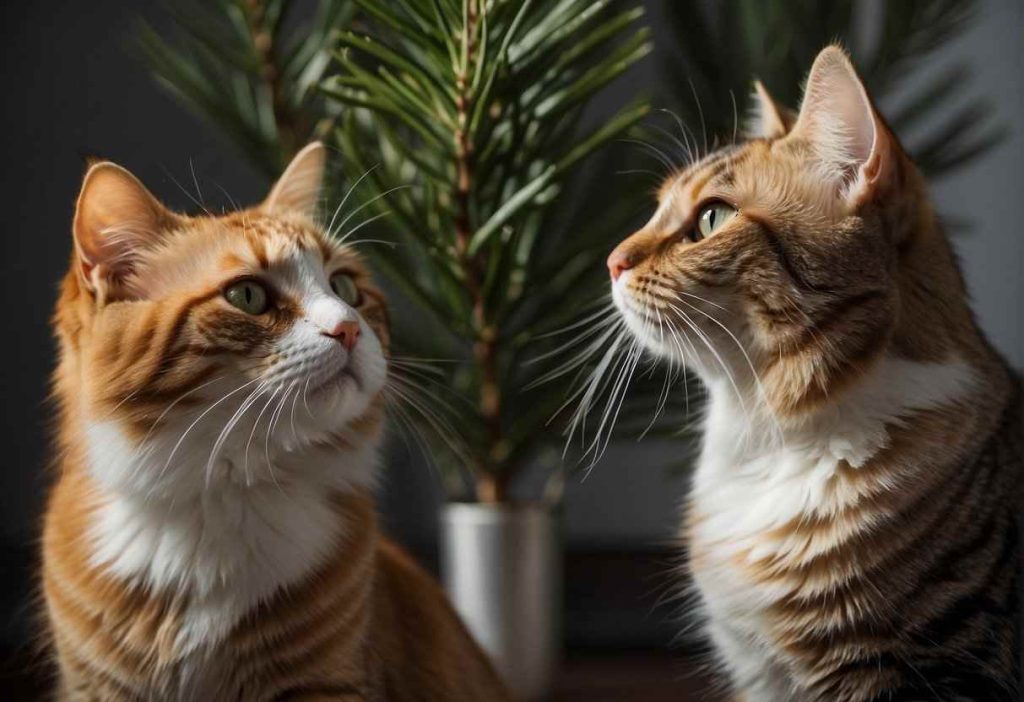
Here’s a lifeline you can trust:
- ASPCA’s Animal Poison Control Center: Hailed as a comprehensive resource, it’s a powerhouse of information regarding plant toxicity.
- Website: aspca.org
- Non-toxic Plants list: A directory of plants that are safe for your pets.
Table of Safety
| Plant Name | Toxicity to Cats | Resources |
| Norfolk Island Pine | Debated* | ASPCA |
*While sources conflict, due diligence is key, especially since experts like Signe J. Plunkett, and DVM suggest potential toxicity.
And remember, your furry pal depends on you to keep their exploration grounds safe.
So, before bringing that pas-sprucing Norfolk Pine into your home, take a moment to check in with your vet or do a quick search in a trusted database.
Because what’s better than enjoying greenery at home? Enjoying it with peace of mind, knowing your cat is safe and sound!
Creating a Pet-Safe Plant Environment
Let’s talk about how you can keep your cats purring and your plants thriving together. First things first, prioritize non-toxic plants. Choose greens that won’t cause a ruckus if the kitty takes an exploratory nibble.
For instance, a Norfolk Island Pine can add festive flair without worry—yep, they’re safe for cats!
Now, let’s get creative with plant placement:
- Place taller plants on sturdy shelves or hanging planters—out of the way of those curious paws.
- Consider decorative barriers like small fences or stylish screens to protect both plants and pets.
Thinking about a mini indoor garden? Make it a cat-friendly zone with these tips:
- Research: Always check if a plant is pet-friendly before bringing it home.
- Avoid small, chewable plants on lower surfaces—curiosity could lead to an unwanted snack.
Engage with education: Stay updated on pet-safe horticulture. Quick online checks and keeping a handy list of “safe” and “hazardous” plants can go a long way.
Remember, vigilance is your best pal. It’s just about striking a balance—blending your green paradise with pet safety for a happy, harmonious home. Isn’t that a purr-fect idea? 😸🌿
Quick Recap
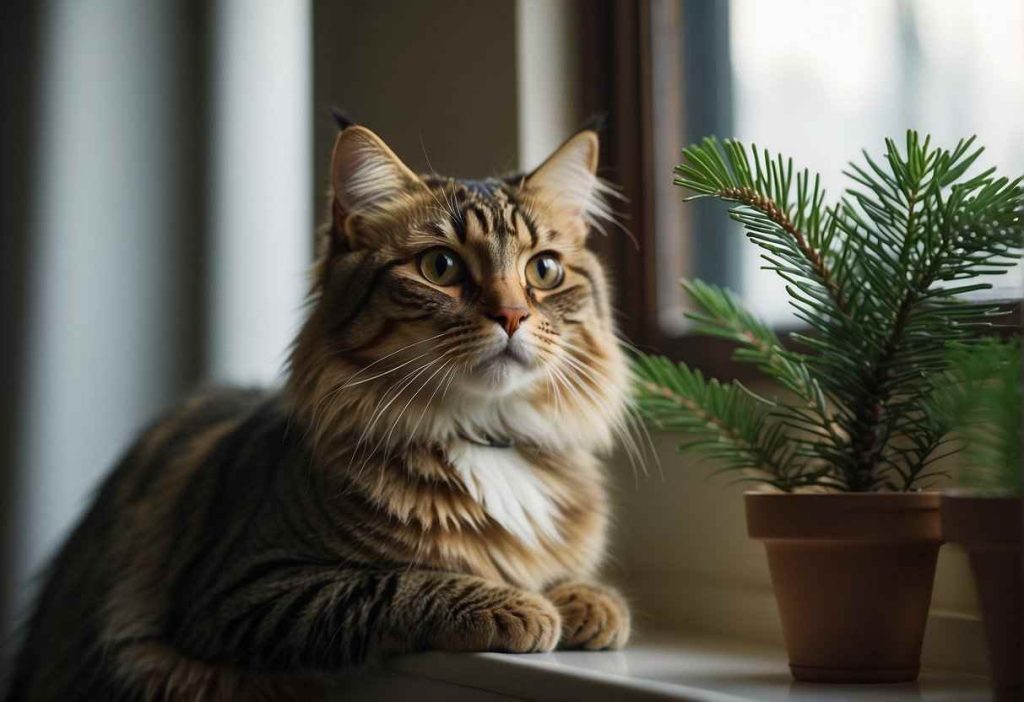
Aren’t cats just the little explorers of our homes? If you’ve watched your furry friend prowl around your living room jungle, you might have wondered if that lovely Norfolk Island pine is safe for them.
Well, there’s a bit of a debate on this subject, so let’s sort through the clutter.
What we know:
- Scientifically Speaking: Norfolk Island pine is known as Araucaria heterophylla. (7)
- Family Ties: It belongs to the family Araucariaceae, like the monkey puzzle tree.
- Location, Location: These pines are native to, you guessed it, Norfolk Island in the Pacific Islands.
Safety Status:
- Green Light from Some: Organizations like the ASPCA list Norfolk Island pine as non-toxic to cats.
- Red Flags Raised: Contrarily, some experts, like Signe J. Plunkett, DVM, flag Norfolk pines as potentially toxic to cats, although the toxic principle remains a mystery.
Symptoms to Watch For:
- Gastro Unpleasantness: Ingesting parts of the tree could cause gastrointestinal upset.
- Skin Deep: Contact may lead to dermatitis in some cases.
Still, as a responsible pet owner, you know it’s better to play it safe.
With conflicting reports, it might be best to keep your Norfolk Island pine out of kitty’s reach or consider a different plant for your indoor oasis entirely.
Remember, curious cats and new plants make for a combination that requires careful consideration. Your four-legged friend relies on you for their safety!
Keep informed, consult with your vet when in doubt, and let’s keep those tails wagging safely around our green friends.
Frequently Asked Questions
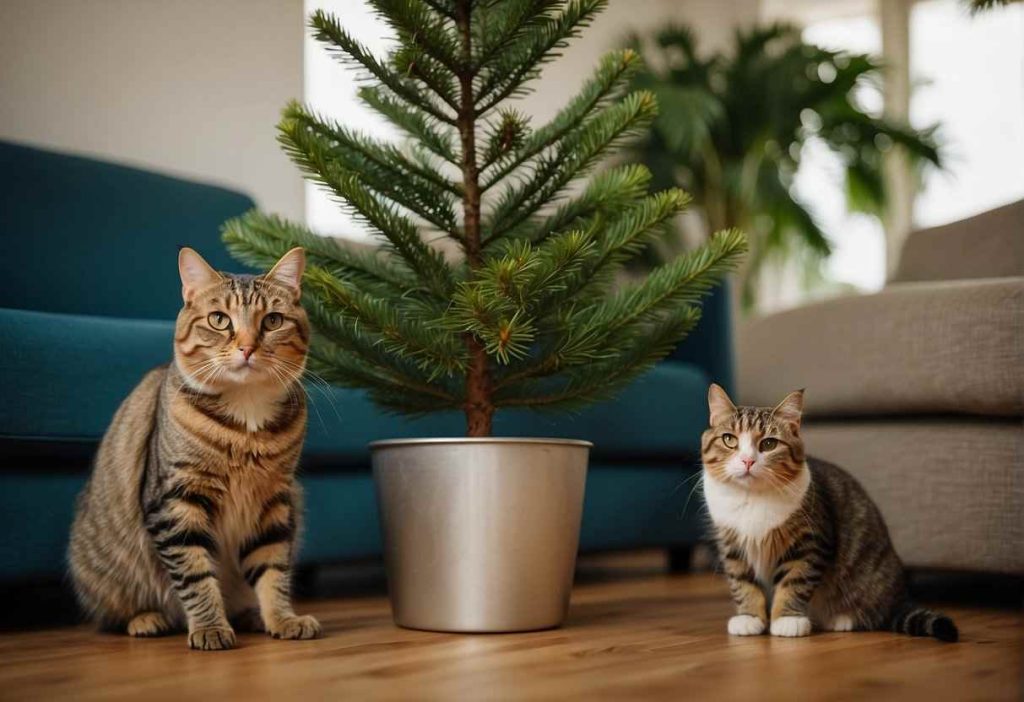
If your curious cat has gotten into your Norfolk Island pine, understanding the potential risks and knowing how to react can be invaluable. Let’s explore your top concerns.
What should I do if my cat nibbles my Norfolk Island pine?
First off, don’t panic. If you see your cat chewing on the needles, remove any plant material from their mouth and observe them closely.
Norfolk Island pine is not highly toxic, but it can cause mild upset.
What immediate symptoms should I look for if my cat ingests Norfolk Pine?
Keep an eye out for symptoms like vomiting, diarrhea, or excessive drooling, as these are signs of gastrointestinal upset. Skin irritation may also occur.
How do I safely remove Norfolk Pine from my cat’s reach without getting rid of the plant?
Elevating the plant on a high shelf or in a room your cat cannot access is a simple solution.
Alternatively, you can use cat deterrent sprays around the plant to keep your kitty at bay.
As an indoor plant lover, what non-toxic alternatives to Norfolk Island pine could I consider?
Great question! Consider pet-friendly plants like spider plants, Boston ferns, or parlor palms. They’re safe and can add that touch of green to your home without worry.
Are there any first-aid steps I should take before reaching a vet?
Yes, rinse your cat’s mouth with water gently. If skin contact occurs, wash the area with mild soap and water. If symptoms intensify, contact your vet posthaste.
Are there any specific care tips for ensuring my Norfolk pine stays healthy without endangering my pets?
Fertilize and treat for pests with pet-safe products. Proximity to bright, indirect light without direct sun exposure is ideal for the Norfolk pine’s health.
Can Norfolk Pine cause long-term health issues in cats if ingested?
Not typically. The risks are usually limited to short-term, mild gastrointestinal or skin irritation. Persistent or severe symptoms merit a vet’s immediate attention.

